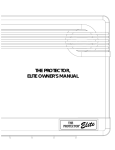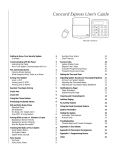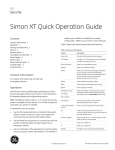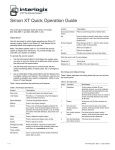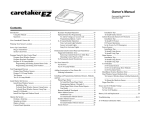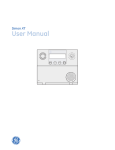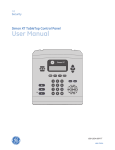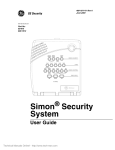Download SIMON OWNER`S MANUAL
Transcript
SIMON OWNER'S MANUAL 0 FCC Notices FCC Part 15 Information to the User Changes or modifications not expressly approved by Interactive Technologies, Inc. can void the user’s authority to operate the equipment. FCC Part 15 Class B This equipment has been tested and found to comply with the limits for a Class B digital device, pursuant to part 15 of the FCC Rules. These limits are designed to provide reasonable protection against interference in a residential installation. This equipment generates, uses, and can radiate radio frequency energy and, if not installed and used in accordance with the instructions, may cause harmful interference to radio communications. However, there is no guarantee that interference will not occur in a particular installation. If this equipment does cause harmful interference to radio or television reception, which can be determined by turning the equipment off and on, the user is encouraged to try to correct the interference by one or more of the following measures: • • • • Reorient or relocate the receiving antenna. Increase the separation between the equipment and receiver. Connect the affected equipment and the panel receiver to separate outlets, on different branch circuits. Consult the dealer or an experienced radio/TV technician for help. FCC Part 68 This equipment complies with part 68 of the FCC Rules. Located on this equipment is a label that contains, among other information, the FCC registration number and the ringer equivalence number (REN) for this equipment. If requested, this information must be provided to the telephone company. The REN is used to determine the maximum number of devices that may be connected to your telephone line. In most areas, the sum of all device RENs should not exceed five (5.0). If this equipment causes harm to the telephone network, the telephone company may temporarily disconnect your service. If possible, you will be notified in advance. When advance notice is not practical, you will be notified as soon as possible. You will also be advised of your right to file a complaint with the FCC. Your telephone company may make changes in its facilities, equipment, operations, or procedures that could affect the proper operation of your equipment. You will be given advanced notice in order to maintain uninterrupted service. If you experience trouble with this equipment, please contact the company that installed the equipment for service and repair information. The telephone company may ask you to disconnect this equipment from the network until the problem has been corrected or you are sure that the equipment is not malfunctioning. This equipment may not be used on coin service provided by the telephone company. Connection to party lines is subject to state tariffs. ©1997 INTERACTIVE TECHNOLOGIES, INC. ITI is a registered trademark of Interactive Technologies, Inc. SIMON ™ is a trademark of Interactive Technologies, Inc. Specifications are subject to change. Some features are optional. For reprints, order manual 466-1302 Rev C Date 5/30/97 1 TABLE OF CONTENTS Introduction to Your System - - - - - - - - - - - - - - -3 Security System Communication - - - - - - - - - - -4 How to Use Your Control Panel - - - - - - - - - - - -6 How to Use Your Touchpads - - - - - - - - - - - - - -8 Programming Your System - - - - - - - - - - - - - - -9 System Tests & Trouble Messages - - - - - - - 11 Your Emergency Evacuation Floor Plan - - - - 13 Alarm System Limitations - - - - - - - - - - - - - - 14 Quick Reference Table - - - - - - - - - - - - - - - - 15 Important Messages to the Owner: In the following paragraphs there may be some terminology that you are not familiar with. Reread this section after you familiarize yourself with your security system. Arming Your System with Doors or Windows Open: Any sensors which are open when the system is armed will be bypassed after the exit delay has expired. This means they will not be protecting your home. If you wish to bypass a sensor after you have armed your system, you must first disarm the system, then open the door or window which you want bypassed. Your system will tell you if a protected door or window is open when you arm the system. If your system includes 24-hour protection sensors on items such as gun or jewelry cases, you must place the panel in program mode before accessing these areas to avoid causing an alarm. CAUTION! If you use the Control Panel to arm your security system when leaving your home, you need to be aware of the following: You need to exit before the end of the delay period or an alarm will sound. Remember, when you arm you will hear 2, 3, or 4 beeps at the beginning of the exit delay (see the table on page 4 of this manual to determine the meaning of system beeps). At the end of the exit delay, the system beeps 2, 3, or 4 additional beeps. If you exit at that time, your system assumes you left and are now returning to your home. The system is now counting down the entry delay time and will expect you to disarm the system within the entry delay time or it will alarm. Something may have happened while you were away! If you enter your home and controlled lights that are normally off are on and/or you hear alarm sirens, an intruder may be inside or another emergency may have occurred. Leave immediately, and call for non-medical emergency help. Canceling Accidental Alarms: You have __ seconds (programmable by the installer from 5-120 seconds) after causing an accidental alarm to disarm your security system. See your installer to determine this amount of time. If the programmed seconds have passed, you must call the central monitoring station to cancel the alarm. Notices for UL-Listed Installations: • • • This system is suitable for Grade A household burglary applications. The Freeze Sensor, Glass Guard and Shock Sensors are not UL Listed. The garage door opening feature used with this system has not been evaluated by UL. 2 Introduction to Your System Your security system uses wireless technology to warn your family about intrusion and fire. It may also be used to control lights and appliances within your home. The system is designed to be monitored and/or to send messages to a numeric pager. system primarily from within the home. KeyChain Touchpads KeyChain Touchpads are used to control the security system from within or near the outside of your home. Indoor Motion Sensors The security system uses devices called sensors which use radio waves to communicate alarms to the control panel. Indoor Motion Sensors detect motion. They may be used for intrusion protection or to sound chimes. The system is supervised, meaning that the control panel checks the status of each sensor to detect problems. If the control panel detects trouble it will notify you with beeps and indicator lights on the control panel itself. Outdoor Motion Sensors Typical Security System Components Door/Window Sensors A typical security system installation consists of the following devices: Control Panel The Control Panel is used to operate and program your security system. It communicates to you through panel voice messages, panel beeps, and by lighting buttons on the control panel. The Control Panel can communicate to a central monitoring station and/or a numeric pager. Remote Handheld Touchpad Outdoor Motion Sensors detect motion in a protected outdoor area and can sound chimes or turn on outside lights. They are not used for intrusion detection. Door/Window Sensors detect the opening of a door or window. Smoke Sensors Smoke Sensors detect smoke. They have a built in siren which sounds when smoke is detected. Modules Modules are used to control lights, appliances, and a garage door. Remote Handheld Touchpads are used to control the security DOOR/WINDOW SENSOR MOTION SENSOR SMOKE SENSOR SYSTEM STATUS ARM Doors & Windows ARM Motion Sensors DISARM KEYCHAIN TOUCHPAD 2 3 4 5 6 7 8 9 1 On Off EMERGENCY - Press & Hold Both K eys ON REMOTE HANDHELD TOUCHPAD OFF 15 1 3 O 5 13 11 9 7 UNIT CODE A C E M K I G HOUSE CODE X-10 POWERHOUSE CONTINUOUS MOMENTARY SOUNDER ONLY SOUNDER & RELAY RELAY ONLY 15 1 3 5 13 11 O GARAGE DOOR MODULE 9 A 7 C E M K I G 15 1 3 5 13 11 LAMP MODULE O 9 A 7 C E M K I G APPLIANCE MODULE 3 8988G21A.DS4 Security System Communication Your security system communicates to you through the use of panel voice messages, panel beeps, indicator lights on the panel itself, and a numeric pager. You communicate to your security system with key presses on the Control Panel and Touchpads. Disarming and programming require you to input a 4-digit access code. The Master Access Code is 1-2-3-4 when the security system is shipped from the factory. You should change it to a code known only by you. Panel Voice Messages When you press the buttons on the Control Panel or the touchpads, the Control Panel responds with voice messages. Panel voice can be enabled or disabled (see Programming Your System on page 9). These messages may respond with system information or prompt you to take further action. For example, if you want to disarm the system and you press the DISARM button, the Control Panel responds by saying, Please enter your access code. If you press a button and the feature has not been programmed into the Control Panel, the panel voice will respond with Function not available. An example could be pressing the Control Panel button CHIME Special Motion when you have no Motion Sensors in your installation. The panel voice would respond with, Function not available. Panel Beeps Panel beeps are used to indicate keypresses, status, and problems with the system. Panel beeps can be enable or disabled (see Programming Your System on page 9). Use the following table to understand the beeps used by the security system. Activity Beep Response ARM Doors & Windows Exit delay beeps sound 2 times when you arm and 2 times at the end of the delay time; Entry delay beeps sound 2 times every 5 seconds and 2 times per second during the last 10 seconds ARM Motion Sensors Exit delay beeps sound 3 times when you arm and 3 times at the end of the delay time; Entry delay beeps sound 3 times every 5 seconds and 3 times per second during the last 10 seconds ARM Doors/Windows & Motion Sensors Exit delay beeps sound 4 times when you arm and 4 times at the end of the delay time; Entry delay beeps sound 4 times every 5 seconds and 4 times per second during the last 10 seconds DISARM 1 beep CHIME DOORS & CHIME SPECIAL MOTION 2 beeps (feature must be programmed by installer) TEST SENSORS Beeps when sensor tripped EMERGENCY Beeps and sirens are activated Trouble Beeps 6 beeps every minute. Press SYSTEM STATUS button to stop beeps for 4 hours 4 Alarm Sirens and Lights Exterior and interior sirens make 3 different alarm sounds on the premises, each indicating a different type of alarm. Sirens will time-out and stop sounding after 4 minutes. System controlled lights also indicate the type of alarm. Use the following table to understand alarm sounds and controlled lights. Alarm Type Interior Siren Sound Exterior Siren Sound System Controlled Lights Fire On steady On steady On steady Intrusion Slow on-off Slow on-off Flashing Emergency Fast on-off On steady Panel Indicator Lights Use the following table to understand the panel indicator lights. Button When the Button Light is On When the Button Flashes ARM Doors & Windows Doors/Windows armed Doors/Windows armed & No Entry Delay on ARM Motion Sensors Motion Sensors armed Motion Sensors armed & Latchkey on DISARM System disarmed SYSTEM STATUS System trouble or Open Sensor CHIME Doors Door will cause chime CHIME Special Motion Motion will cause chime LIGHTS Time Activated Light schedule is on LIGHTS Sensor Activated Sensors will cause light to go on System in alarm Numeric Pager Your installer may have programmed your security system to send a numeric message indicating system activities to your pager. Use the following table to determine what the numeric message is reporting. 5 Reports Numeric Message Phone Test 111 111 AC Power Restoral 222 222 AC Power Failure 333 333 Latchkey 444 444 No Activity 555 555 Emergency 777 777 Intrusion 888 888 Fire 999 999 How to Use Your Control Panel The Control Panel interface consists of 3 columns of buttons. They are: HOME SECURITY, CODE, and HOME CONTROL. There is a non-medical EMERGENCY button located on the far right. HOME SECURITY DISARM Press once and enter your access code using the ARM Doors & Windows Press once to turn the security system protection on for all protected doors and windows. If a door or window is open when you arm the system, it will be bypassed, meaning not protected. The SYSTEM STATUS light will be lit. Press twice to eliminate the preprogrammed entry delay. The button blinks when No Entry Delay is on. ARM Motion Sensors Press once to turn protection on for all intrusion Motion Sensors. Use when no one is home. This is usually used in combination with ARM Doors & Windows. Press twice to activate Latchkey. Latchkey is used to notify parents if your children do not arrive home at a predetermined time and disarm the system. The button blinks when Latchkey is on. CODE buttons to turn security protection off. Some sensors, like smoke detectors and panic devices, are still active even when the system is disarmed. SYSTEM STATUS Press once to hear information about your system. If the button is lit, there is a problem with the system. If the button is blinking, an alarm has occurred. Press the button to hear what is wrong with the system. See Trouble Message information on page 11. CODE There are 5 CODE buttons located on the left side of the Control Panel. Each button represents 2 numbers. The top CODE button is 1 - 2 which means that this button is pressed when entering either 1 or 2. For example, if your access code is 1-2-3-4 you must press the 1 - 2 button twice and the 3 - 4 button twice. CODE HOME SECURITY HOME CONTROL 1-2 ARM Doors & Windows CHIME Doors 3-4 ARM Motion Sensors CHIME Special Motion EMERGENCY 5-6 LIGHTS Time Activated DISARM 7-8 LIGHTS Sensor Activated SYSTEM STATUS 9-0 Test Weekly 8988G12A.DS4 6 HOME CONTROL LIGHTS Time Activated Press to enable system controlled lights to turn on and off at scheduled times. If any of the HOME CONTROL buttons are pressed and a sensor or module is not associated (programmed) with this feature the Control Panel will say, Function not available. CHIME Doors Press to cause the Control Panel to beep when protected doors or windows are opened. This is a nice feature to use if you’re busy in one part of your home and you want to know when family members are going in and out of your home. CHIME Special Motion Press to cause the Control Panel to beep when Motion Sensors detect movement within a specific area. These Motion Sensors are not used for intrusion protection. If you have Motion Sensors located in areas such as in a patio area or at the front door and you want to know when someone is approaching these areas, you would use this feature. An example is turning your living room lights on at 7 pm and off at 10 pm. LIGHTS Sensor Activated Press to have specially programmed sensors turn on lights for 4 minutes when sensors are tripped. An example is using an outdoor Motion Sensor at the front door. When the Motion Sensor detects movement it will cause the light at the front door to turn on. You may also program the star button on the KeyChain Touchpad to turn on a light for 4 minutes. EMERGENCY Press EMERGENCY for 2 seconds or twice quickly to call the central monitoring station and notify them of a non-medical call for help. CODE HOME SECURITY HOME CONTROL 1-2 ARM Doors & Windows CHIME Doors 3-4 ARM Motion Sensors CHIME Special Motion EMERGENCY 5-6 LIGHTS Time Activated DISARM 7-8 LIGHTS Sensor Activated SYSTEM STATUS 9-0 Test Weekly 8988G12A.DS4 7 How to Use Your Touchpads Touchpads are used to control the security system from any location within or near your home. They have additional home control features such as light and appliance control. Remote Handheld Touchpad SYSTEM STATUS Press once to hear information about your system. See Trouble Message information on page 11. SYSTEM STATUS ARM Doors & Windows Press once to turn the security system protection on for all protected doors and windows. Press twice to eliminate the preprogrammed entry delay. ARM Doors & Windows ARM Motion Sensors ARM Motion Sensors Press once to turn protection on for all Motion Sensors. Use when no one is home. This is usually used in combination with ARM Doors & Windows. Press twice to activate the Latchkey feature. DISARM 1 2 3 4 5 6 7 8 9 On DISARM Press once and enter your access code using the NUMERIC buttons to turn security protection off. ON Light button Press twice quickly to activate all lights controlled by the security system. You may turn on specific lights and appliances by pressing this button once and entering the unit number of a light or appliance using the NUMERIC buttons. Off EMERGENCY - Press & Hold Both K eys 8988G07A.DS4 OFF Light button Press twice quickly to turn off all lights. You may turn off specific lights and appliances by pressing this button once and entering the unit number of the light or appliance. EMERGENCY Press both EMERGENCY buttons for 3 seconds to cause the system to call a central monitoring station to report a non-medical emergency. KeyChain Touchpad LOCK Press once to arm doors and windows. LOCK Press twice to arm doors, windows, and Motion Sensors. LOCK Press 3 times to arm doors, windows, Motion Sensors, and to activate the Latchkey option. Entering your home If your installer programmed the KeyChain Touchpad with no entry delay, and you armed the system with the KeyChain Touchpad, you must disarm your system from outside of the home to avoid causing an alarm. Exiting your home You have at least 5 seconds and up to 120 seconds (depending on installer programming) to leave without causing an alarm. LOCK and UNLOCK Press both buttons simultaneously for 3 seconds to send an intrusion, silent, or non-medical emergency alarm to the central monitoring station. 8348G03A.DS4 UNLOCK Press to disarm your security system. LIGHT Press to turn system controlled lights on or off. STAR Press to open or close your garage door, if programmed, or your system may be programmed to turn on a light using this button. For any keypress on the KeyChain Touchpad, hold the button until the indicator light blinks. 8 Programming Your System What You Can Change: Options: Option 01 - Panel Beeps Panel Beeps are any beeps (including chime beeps) that come from the Control Panel, and may be disabled, except for alarm sirens. See Panel Beeps page 4. Option 02 - Panel Voice Panel Voice may be disabled except for status messages, open sensor responses, and when in program mode. Option 03 - Latchkey Time Adding this option allows you to program Latchkey Time. See Arm Motion Sensors page 6. Press Add in the START MENU and follow the voice prompts to turn an option on. Press Delete in the START MENU to turn an option off. Access Codes Your security system has a master access code and access codes 1-5. They are used for disarming and programming your system. They have the same privileges except access codes 1-5 cannot change any access codes. Access codes 1-5 are generally used for children or as temporary codes for a babysitter or service personnel. Time Activated Lights Entry/Exit Activated Lights Sensor Activated Lights Set Clock House Code Sensor Test or Phone Test Programming Decals (Upper Decal and Lower Decal) The programming decals are visible when you open the Control Panel cover. These decals are designed to make system programming easier for you. Always begin by choosing a button from the START MENU. Follow the voice prompts and flow arrows to complete the desired task. Notice the button flow diagrams under Instruction Summary to the right of the buttons and on the lower decal. 9 Step by Step Programming Instructions Use the following instructions to access the programming buttons and programming decals. 1. Open the Control Panel Cover by pressing the plastic latch on the top of the Control Panel. When you open the cover you will immediately be prompted by the Control Panel voice to use the red numbered keys to enter your ID. 2. Enter Your Access Code. The Master access code is 1-2-3-4 when the panel is shipped. You should change it to a code known only by you. 3. The system voice will prompt you to begin with the START MENU. The START MENU is located on the left side of the upper decal. The START MENU includes the following buttons: Add Delete Cancel Test Clock Set The MAIN MENU includes the following buttons: Option # Sensor/Remote Access Code Light Control Press the appropriate button. Depending on the button you pressed, the system will prompt you to continue by pressing other buttons on the panel. How to Change an Access Code 1. 2. 3. 4. 5. 6. 7. Open the cover of the Control Panel. The panel voice prompts you to Use red numbered keys to enter 4-digit ID. Enter your master access code using the red numbered keys. The panel voice prompts you to Please select from START MENU. Press the Add button on the START MENU. The panel voice prompts you to Select from MAIN MENU. Press the Access Code button on the MAIN MENU. The panel voice responds with Master Code, press again for next access code or DONE to select or CANCEL to quit. Press the access code button again to hear the next access code. When you hear the access code you wish to change press the DONE Button. Enter 4 new numbers using the red numbered keys. Close the Control Panel cover. Press the appropriate button. 4. After pressing a button on the START MENU the system voice will prompt you to then use the MAIN MENU. 10 System Tests & Trouble Messages Automatic Control Panel Testing-What the System Tests for You Your security system is able to automatically test itself for: • Power failures • Low batteries • Non-working sensors • Communication troubles with the Central Monitoring Station Trouble Messages Trouble Beeps When your security system detects one of the problems above, interior sirens sound trouble beeps rapidly six times, and then again every minute, until the trouble condition is corrected. If you do a status check by pressing the SYSTEM STATUS button or change the system from being armed to disarmed or disarmed to armed, the beeps will stop. If the problem is not corrected, beeps start again 4 hours later. Silencing Trouble Beeps Pressing the SYSTEM STATUS button or changing from armed to disarmed or disarmed to armed while the system has a trouble condition stops the trouble beeps. Trouble beeps begin again 4 hours later, in some cases, unless the trouble condition is corrected. AC Power Failure This condition occurs if your security system has been accidentally unplugged or if there has been an AC power outage. The backup battery will take over. If AC power is not restored within 15 seconds, the Control Panel will go dark and alert you with trouble beeps. If you press any button, the display will light and pressing SYSTEM STATUS will confirm the AC power failure. If AC power is not restored within 15 minutes, the system will call the central monitoring station (if programmed by installer). System Battery Failure This condition occurs if the emergency backup battery has been drained and must be replaced. Trouble beeps will start and the SYSTEM STATUS button will light. Press the SYSTEM STATUS button to hear the trouble message. If your AC power is not working, your security system will shut down once the battery is drained. The Control Panel battery should be replaced once a year. Call your security system dealer for replacement service. 11 Sensor Failure This condition occurs if a sensor is not communicating with the Control Panel. Trouble beeps will start and the SYSTEM STATUS button will light. Press the SYSTEM STATUS button to hear which sensor(s) have trouble. Perform sensor tests. It may be necessary for you to call your security system dealer if the problem continues. Sensor Low Battery This condition occurs if a system sensor has a low battery. The sensor may still be communicating with the Control Panel. Trouble beeps will start and the SYSTEM STATUS button will light. Press the SYSTEM STATUS button to hear which sensor(s) have trouble. It may be necessary for you to call your security system dealer to resolve this problem. Some sensor batteries can be replaced by the homeowner. Fail-To-Communicate This condition occurs if your security system cannot communicate to the central monitoring station. Your system will try to report to the central monitoring station 3 times before it tells you there is a Fail-To-Communicate problem. Trouble beeps will start and the SYSTEM STATUS button will light. Press the SYSTEM STATUS button to hear the trouble message. It will then try 5 more times to communicate. It may be necessary for you to call your security system dealer if the problem continues. Sensor Open This condition occurs if a door or window is open; or a system sensor has been disturbed or tampered and not reset properly. For example, a Motion Sensor may be off the wall or a Door/Window Sensor cover may have been removed from the sensor. Your system will indicate this condition to you by causing the SYSTEM STATUS button to light. When you press this button, the system responds with Sensor # Name open. Correct the problem by reseatting the sensor. If this condition continues call your security system dealer. Clearing System Status If a trouble condition is corrected, press the SYSTEM STATUS button then disarm the system to clear system status. If the trouble condition was a low CPU battery, perform a sensor test. The SYSTEM STATUS button should turn off if all trouble conditions have been corrected. Manual Tests--What You Need to Test Sensor Tripping Instructions Sensor As an added safeguard, there are system tests you should do yourself on a regular basis. The Control Panel cover in the lower left corner reminds you to TEST WEEKLY. Sensors Rate-of-Rise Heat Detector Rub your hands together until warm, then place one hand on the detector for 30 seconds Shock Tap the glass twice, away from the sensor. Wait at least 30 seconds before testing again Smoke Press and hold the test button until the system sounds transmission beeps Panic Buttons Press and hold the appropriate panic button(s) for 3 seconds KeyChain Touchpad Press and hold LOCK and UNLOCK simultaneously for 3 seconds Remote Handheld Touchpad Press and hold the 2 EMERGENCY buttons simultaneously for 3 seconds You can test sensors one at a time to make sure they are sending strong signals to the Control Panel (see next page). Communication You can also test the communication between your system and the Central Monitoring Station (see next page). Testing Sensors You should test the security system at least once each week. To perform the sensor test: 1. Open the Control Panel Cover. 2. Enter your access code 3. Press the TEST button once 4. Press the DONE button The panel will voice prompt you with a list of your programmed sensors that you need to test. The panel will start with sensor 1 and say Test sensor 1, sensor name. When you trip a sensor and it communicates successfully it will be removed from the list. You may trip the sensors in any order. After all sensors have been successfully tested, the Control Panel will say Sensor test complete, press DONE. Press DONE. The Control Panel will say Sensor test ok. If any of the sensors did not test successfully and you want to terminate the test, press DONE. The Control Panel will say Sensor test canceled or failure. If a sensor test fails, call your security dealer. Use the following table to trip sensors. Do This Testing Communication Test communication with your central monitoring station at least once per week to make sure you have the proper telephone connection between your system and the central monitoring station. To perform a phone test: 1. Open the Control Panel cover. 2. Enter your access code 3. Press the TEST button twice. 4. Press the DONE button. The Control Panel will say Phone test is on twice. If the test is successful the Control Panel will say Phone test ok within 2 minutes. If the test is unsuccessful, the SYSTEM STATUS button will light and the Control Panel will say Phone communication failure within 10 minutes. If a phone test fails, call your security system dealer. Sensor Tripping Instructions Sensor Do This Door/Window Open the secured door or window Freeze Apply ice to the sensor. Do not allow the sensor to get wet. Glass Guard Tap the glass 3 or 4 inches from the sensor Motion Sensor Avoid the Motion Sensor’s view for 5 minutes, then enter its view NOTE: If your system is not connected to a central monitoring station, you won’t be able to perform the phone test. . 12 Your Emergency Evacuation Floor Plan Planning for Emergencies This section describes what you can do to plan ahead for an emergency: • Emergency Planning • Your Floor Plan • • • • Emergency Planning Since an emergency is always unexpected, you should develop plans to help prepare for a variety of emergency situations. Periodically discuss and rehearse emergency plans to include the following: • Understand how to use your security system • Know the normal state of doors and windows; open, closed, or locked. • Escape fast! (Do not stop to pack.) • Use a different escape route if closed doors feel hot to the touch. • Crawl and hold your breath as much as possible to help 13 • reduce smoke inhalation during your escape. Meet at a designated outdoor location. Emphasize that no one should return to the premises if there is a fire. Notify the fire department from a neighbor’s phone. Emphasize that no one should enter the premises if they hear sirens in the house. If you arrive at the premises and hear sirens, do not enter. Call for emergency assistance from a neighbor’s phone. Your Floor Plan Use the following guidelines when drawing your floor plan: • Show all building levels. • Show exits from each room (two exits per room are recommended). • Show the location of all security system components. • Show the location of any fire extinguishers. Alarm System Limitations Not even the most advanced alarm system can guarantee protection against burglary, fire, or environmental problems. All alarm systems are subject to possible compromise or failure-to-warn for a variety of reasons. • • • • • • • If sirens are not placed within hearing range of persons sleeping or in remote parts of the premises, or if they are placed behind doors or other obstacles. If intruders gain access through unprotected points of entry or areas where sensors have been. If intruders have the technical means of bypassing, jamming, or disconnecting all or part of the system. If power to sensors is inadequate or disconnected. If freeze or any environmental sensors are not located in areas where the appropriate condition can be detected. If smoke does not reach a Smoke Sensor. For example, Smoke Sensors cannot detect smoke in chimneys, walls, roofs, or smoke blocked by a closed door. Sensors may not detect smoke in other levels of the building. Sensors may not warn in time when fires are caused by smoking in bed, explosions, improper storage of flammables, overloaded electrical circuits, or other hazardous conditions. If telephone lines are out of service. Telephone lines are also vulnerable to compromise by any of several means. Inadequate maintenance is the most common cause of alarm failure. Therefore, test your system at least once per week to be sure sensors, sirens, and phone communications are all working correctly. Although having an alarm system may make you eligible for reduced insurance premiums, the system is no substitute for insurance. WARNING: Security system devices cannot compensate you for the loss of life or property. Service If you have any questions about your security system or if you ever need service, please contact your security consultant. Company Name _____________________ Phone Number _____________________ Address _____________________ _____________________ 14 Quick Reference Table FUNCTION PRESS CONTROL PANEL REMOTE HANDHELD TOUCHPAD To arm the system -- Doors & Windows ARM Doors & Windows ARM Doors & Windows To arm the system -- Motion Sensors ARM Motion Sensors ARM Motion Sensors To arm the system -- Doors/Windows & Motion Sensors ARM Doors & Windows To activate No Entry Delay ARM Doors & Windows To activate the Latchkey feature ARM Motion Sensors ARM Doors & Windows ARM Motion Sensors Press Twice ARM Doors & Windows Press Twice ARM Motion Sensors Press Twice ARM Motion Sensors Press Twice To disarm the system Doors/Windows & Motion Sensors DISARM + Access Code DISARM + Access Code To send an alarm to the Central Monitoring Station EMERGENCY Press & hold for 3 seconds To check the system status SYSTEM STATUS To set doors to Chime CHIME Doors To set Special Motion Chime CHIME Special Motion To set lights to time activated LIGHTS Time Activated To set lights to sensor activated LIGHTS Sensor Activated KEYCHAIN TOUCHPAD Press Twice Press Twice If Programmed Press 3 Times Press both EMERGENCY buttons. Press & hold for 3 seconds. Press & hold for 3 seconds SYSTEM STATUS To open a garage door or turn on special lights 15 466-1302 Rev. C
















